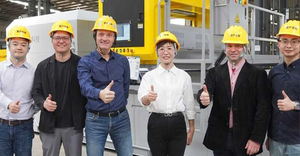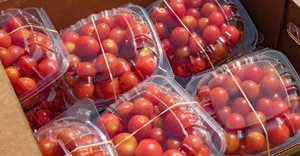Increasing compaction can help a landfill bring in more money.
July 1, 2010
Matthew Fountain, Tom Flannagan and Leonard Joyce

REGULAR CHECK-UP: Landfills should conduct regular surveys to track how operational changes are impacting waste density
A landfill manager's three principal goals are safety, regulatory compliance and profitability. The manager who methodically finds the most efficient way to manage his site's airspace will increase the amount of money that his facility can make.
A higher compaction density means bigger profits. For example, a 50-acre facility with 5 million cubic yards (cu. yd.) of airspace, a disposal fee of $35 per ton, and a compaction rate of 1,600 pounds (lbs.) per cu. yd. can bring in $35 million more in revenue over the course of its lifespan than a similar facility with a compaction rate of 1,200 lbs./cu. yds.!
The basic variables covered in this article represent some of the potential methods of increasing compaction. It is important to understand that these strategies are a balancing act and that each change will impact other compaction factors.
The first step to improving compaction at a landfill is to measure the site's current density. The primary way to determine density is to conduct two surveys of the active landfill area and calculate the airspace used between the survey dates. Take the total scale weight of waste disposed during that period and divide by the airspace used during that period to obtain the weight of waste per cubic yard.
Facilities should conduct regular surveys to track how operational changes are impacting waste density. Surveys should be conducted quarterly at facilities handling more than 1,000 tons per day, and semi-annually or annually at sites that take in less than 500 tons per day. Surveys cost pennies per ton, and the information gained is invaluable. Furthermore, GPS programs that were too cost-prohibitive for individual site use a few years ago have improved in pricing and matured in capabilities. Higher-end systems often can provide equipment operators and site managers with densities of disposed waste in real time.
A municipal solid waste landfill should strive for a density of least 1,200 lbs./cu. yd. and, in some cases, can achieve a rate as high as 1,800 lbs./cu. yd. Cost/benefit analysis for revising compaction activities may be evaluated using a cost-per-cubic-yard basis. Using the example of the facility example above — with a $35-per-ton gate rate and a waste density of 1,600 lbs./cu. yd. — each cubic yard of airspace is worth $28 in potential revenue ($35/ton x 1,600 lbs./cu. yd. x 1 ton/2,000 lbs.).
To improve compaction and profitability, only one change to compaction activities or cover soil usage should be made between each survey so that the benefit of the change can be calculated and compared to the cost. In this manner a series of changes can be made over time to maximize compaction.
Equipment Selection
Selecting an appropriately sized compactor for a landfill balances additional compaction with increased capital, fuel and maintenance costs. When choosing a compactor, select the largest machine that will be fully employed given a site's waste stream tonnage. If too large a machine is used, the target compaction will be achieved with spare time available for more passes. This extra time results in the compactor being idled intermittently, or operated past the point at which it would provide additional compaction. If the compactor is too small, waste density will not be optimized.
The general rule of thumb for selecting a compactor is that a 50,000 lb. machine can handle up to 500 tons per day, an 80,000 lb. machine can handle between 250 and 750 tons per day and a 120,000 lb. machine can handle between 750 and 1,250 tons per day.
Sites accepting more than 1,250 tons in an eight-hour day should consider adding a second machine. After subtracting the amount of waste managed by the first machine, determine the size of the second machine using the rule of thumb outlined above.
It is important to remember that 80 percent of a landfill's daily incoming waste often is brought to the site during the busiest 30 percent of the workday. In order to help manage these surges of waste, it may be justifiable to upgrade to the next largest size of compactor if the site's daily tonnage is near the cutoff between compactor sizes.
A compactor's wheels also impact waste density. Wheel and cleat selection depends on the make up of the waste stream at each facility. Different wheel designs facilitate chopping, grinding, twisting or a combination of these actions. Consult manufacturers' literature and know your site's exact waste stream composition to evaluate a wheel's strengths and weaknesses. Conduct a survey each time a new wheel or cleat type is installed and compare waste density numbers from different wheels to find the optimal type.
Compactors and wheels are the equipment typically considered for compaction, but the dozer also has a significant impact on waste density because of the role it plays in daily cover activities. If waste intake rates justify a larger class dozer for pushing waste, a smaller dozer should be tasked with the stripping of old cover material before the placement of additional waste and the spreading of new cover material. The precise control afforded by a small dozer allows for detailed site work where inches matter.
In the example of a landfill with 5 million cu. yd. of airspace, a $35-per-ton gate rate, a density of 1,600 lbs./cu. yd. and 10 foot (ft.) high daily lifts, the facility would cost itself $1 million in revenue over its lifetime by leaving an extra inch of daily cover in place each day. To control cover soil usage, reduce the daily number of truckloads of cover soil used. Alternate daily covers can be an excellent airspace savers. These covers include tarps, spray-ons and waste material that has been deemed acceptable for use as cover.
Waste Placement Techniques
The daily filling plan should be designed so the compactor can operate on a flat waste surface and therefore be constantly compacting rather than pushing waste. The compactor should operate at the maximum possible safe speed in order to increase the chopping and grinding of waste materials to reduce particle size and increase density.
Cover soil should be stripped from the area designated for the day's waste placement each morning. Do not contaminate any clean cover soil stockpiles with litter that is caught up in the stripped cover soil.
At the end of each day, after "trimming," spread the previously stripped cover soils and then the clean cover soils. Trimming the working face at the end of the day creates a smoother surface. This means that less clean soil will need to be applied as daily cover, or, in the case of alternative daily covers, that a tarp will have a longer life due to fewer snags or that less spray-on material is needed due to less protruding waste.
After establishing the basics, experiment with alternate placement and compaction techniques between surveys. First find the best working face dimensions for the site using the following technique while remembering that the smaller the working face, the more passes by the compactor — and the more passes by the compactor, the more cleat penetrations and a higher compaction density.
The width of the daily working face is a balance between minimizing hauler wait time and maintaining safe spacing between customer's trucks. With that distance established, attempt to make the height approximately equal to the length of the working face. Interior slopes should have a maximum ratio of 3 horizontal feet to 1 vertical foot to reduce surface area and cover soil. For safety reasons, the working face height generally should not exceed 20 ft.
Next, vary the layer thickness, balancing between gaining time for additional compactor passes with thicker layers and preventing bridging with thinner layers. Use a consistent thickness for periods between short-term surveys of the working area, then change the thickness and survey again to check for improvement.
Generally aim for a layer thickness of two feet of loose waste placed by the dozer. This thickness allows for the constantly moving compactor to make a minimum of three to five passes over every square foot of the daily working face's surface. If layers are too thick for effective compaction but cannot be made any thinner, compactor size may need to be increased.
Alternatively, an additional compactor may be added and or the working face size increased, where the same volume of waste can then be placed into thinner loose lifts, resulting in a more densely compacted daily cell. However, before adding compactors, analyze the site's peak traffic flow times and stockpile "surges" of waste received during busy portions of the day for placement during lower volume time periods. The dozer operators should be moving a consistent rate of waste to the working face, allowing the compactor operator adequate time to "walk the loose lift in."
Another way to increase waste density is to enhance the settlement of the waste. Stockpile soil or other construction materials on top of waste to add weight that will increase the physical settling of the landfill to regain airspace. Access roads also can be designed and routed over existing waste to add both weight and a vibratory compaction from trucks and other equipment. Finally, allow sufficient time for settlement to occur by leaving areas uncapped while expanding the landfill horizontally so that a vertical lift can be added later to settled waste.
Leachate recirculation and recycling certain portions of the waste stream are just a few of the other innovative ways that landfill managers are improving compaction. Regardless of the techniques used, setting a compaction goal and tracking the facility's density improvement is the key to better compaction.
Matthew Fountain and Tom Flannagan are consultants with Joyce Engineering, which is headquartered in Richmond, Va. Leonard Joyce is the founder of the firm.
Related Stories
You May Also Like


